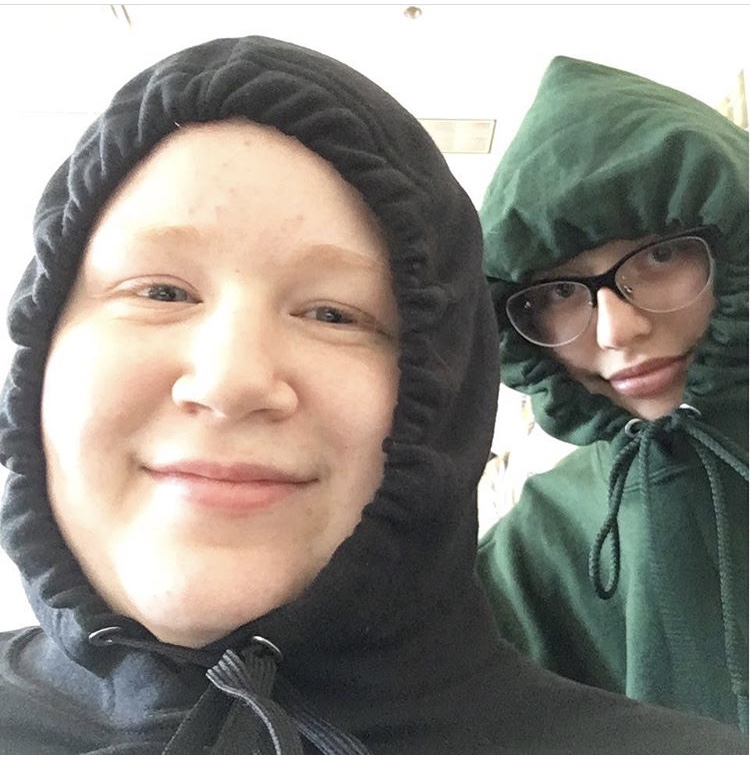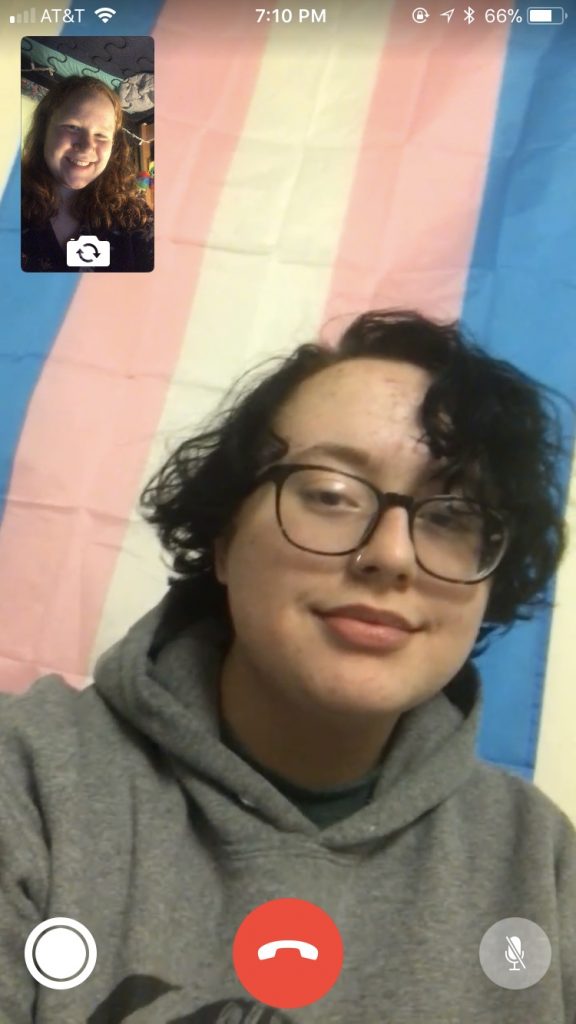Dylan Manning is a nineteen-year-old college student majoring in history. He is a transgender male and identifies as gay (0:59). Dylan is also a good friend of mine whom I had the honor of interviewing about his identity as a transgender individual: his initial struggles, harassment, becoming comfortable with himself, and the issues he continues to face. We also briefly addressed the idea that victimizers sometimes harass other people because of their own insecurities.
I met Dylan at the beginning of my junior year of high school. He was in my history class that year, and I decided I should befriend him when I saw him wearing a Troye Sivan shirt on the first day of class. That impulsive decision to befriend a random guy in class based on the pop star on his t-shirt was a pretty good choice I’d say. Dylan and I laugh about practically everything which made interviewing him a bit of a challenge. I had to cut a lot of sarcastic comments and weird jokes out of the interview transcript because they had little to do with him telling his story of being transgender. However, the ability to laugh and joke with a dear friend throughout the interview made the project enjoyable for both of us.

Dylan is a transgender male, and he was relatively early on in his transition when I met him. I have always been very aware of Dylan being transgender due to how vocal and authentic he is about himself. I have always admired him for that, but previous to this interview I had never had much of an in-depth conversation with Dylan about his journey with being trans. Our friendship made the interview interesting and personal. I built a better connection with a friend of mine, and I now have the opportunity to help share his story.

Photo of Dylan taken by me at Dylan’s 18th birthday party (October 2017),by Maria E Starns, All rights reserved. 
Dylan and our friend Lillian Hilmes,by Maria E Starns, October 2017, All rights reserved.
Early in the interview, I asked Dylan how people initially responded to him being transgender. He said that his friends were generally very supportive (1:59). He did, however, go on to describe instances of harassment he has experienced. One of his friend’s parents actually came into his place of work and gave him trouble. They told him he was too feminine and would “never be a real guy” (3:04). Dylan said that he was just wearing his work uniform and didn’t know how he could have looked more masculine. He told me, “I don’t really know what they wanted me to do. You know, show up to work in cargo shorts?” (3:39). Dylan also described how being trans impacts his daily life. He said that it does not consciously impact him all that much, but it does impact him subconsciously.
It does have a subconscious impact on everything I do because I know that subconsciously I’m trying to make everyone view me very masculine. So, I’m very aware of body language and what I wear […] even though I’m not actively thinking about it a lot I know that it does impact all that I do (4:50).
Dylan described another time he felt particularly unwelcome. He was in a college preparatory program shortly after coming out. He explained that some of the other students in the program simply would not accept that he was trans, and they were being particularly nasty about it. They talked about Dylan behind his back, said that he was too feminine, and used “she” pronouns to describe him. In the interview, he laughed that one off and explained that he usually wore jeans and t-shirts to the program. He thought it was odd that they called him feminine when he dressed in a way that was not particularly gendered. He decided to report what was going on to the program director, but she dismissed the issue as insignificant. He said that she essentially had the mentality of “suck it up” (8:34).
When asked about his immediate reaction to the situation, he said that these hateful actions impacted him on a personal level.
It made me feel very scared and kind of doubtful of myself. Because like I said earlier it took me a really long time to admit to myself that I was trans. Because I didn’t want to experience all the bad stuff that I had heard trans people experience[…] meeting that first-hand experience was terrifying for me because it made me question my safety and […] want to go back into the closet even thought I knew that wasn’t the right decision to do because that would be awful for my mental health” (11:18).
Dylan said that he believes these people acted the way they did towards him because they were insecure about their own identities. He claimed that men with fragile masculinity are commonly the people who have problems with him being transgender. He believes this is because him being a transgender man forces other men to question what makes them men (10:44).
Dylan’s explanation reminded me of the theme in our class that victimizers are often trying to hide something about themselves. We studied the 1959 Eugene Ionesco play Rhinoceros that comments on the spread of Nazism through the metaphor of characters becoming rhinoceros. The character Beouf is never seen on stage but he is mentioned as the first person to become a rhinoceros. He was said to conform quickly as an attempt to hide an insecurity or questionable past. This situation in Rhinoceros is comparable to the guys who questioned Dylan’s masculinity because they were insecure about their own masculinity.

by Maria E Starns, February 2019, All rights reserved.
I also asked Dylan if he would have changed his minimal reaction to the situation given the opportunity. He said he would not have changed his reaction because he did not want to jeopardize his safety.
I always like to fantasize about being in that situation again and like telling them off and having one of those big movie stand up moments. But I don’t think I would actually do anything different because in those moments I didn’t say anything because I was unsafe […] I don’t think it would have been worth it if I reacted any other way (14:41).
I thought this subtly related to the theme of choices in our class. Dylan technically had the choice to fight back but he decided it was not worth it. His safety was more important than telling off a bully. Dylan’s situation differs from the idea of “choice-less choices” presented in our class because Dylan was able to make a good choice for his own safety and well-being. “Choice-less choices” refers to choices that victims have to make that will turn out poorly either way; neither choice is good in these situations.
When I asked Dylan about the hardest issue he still faces today, he mentioned the rejection of trans people from society in general. Inclusivity of the trans community is growing but there is still a general sense of taboo both socially and politically. That is especially true here in Missouri where Dylan lives. Our state lacks legal protections for LGBT individuals in housing, employment, and other public amenities. The ACLU supported Missouri Non-Discrimination Act (MONA) has been presented to the state legislature for more than 20 years in a row. MONA would ensure these legal protections to LGBT individuals but has yet to pass through the legislature (ACLU 2019). Dylan also used this opportunity to explain the fear and trouble of meeting new people.
I only really get nervous about me being trans when I meet new people because I know that not everyone is accepting, and I’m just sort of fearful that they’ll reject me or hurt me in some way […] it impacts a lot of the ways in which I interact with other people (16:24).
One of my favorite parts of the interview was when I asked Dylan what he had learned from being transgender. He took this as an opportunity to describe some of the more positive aspects of him being transgender. Dylan discussed the security he has in his identity and who he is as a result of being trans. Dylan said that if he was given the opportunity to change himself, he wouldn’t (6:55).
I feel like I have a security in my identity that a lot of cis people don’t have. Because I went through the process of questioning my gender and then coming out and then going through the process of accessing hormones and then changing my name. I’ve been through all of this stuff just to be who I really am […] It’s like a relieving experience to know who I am […] and I feel like a lot of people don’t get that experience (17:30).

He also positively spoke of a therapy group for trans people he attends. He said that it’s “nice to be around people who get it” (8:05). He described this as a place where he feels particularly welcome. Despite the people who have put him down for who he is, Dylan has found security in himself.
